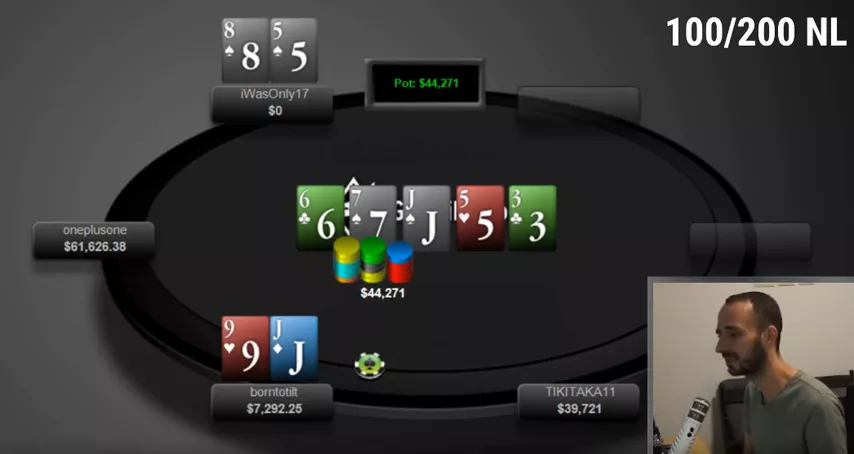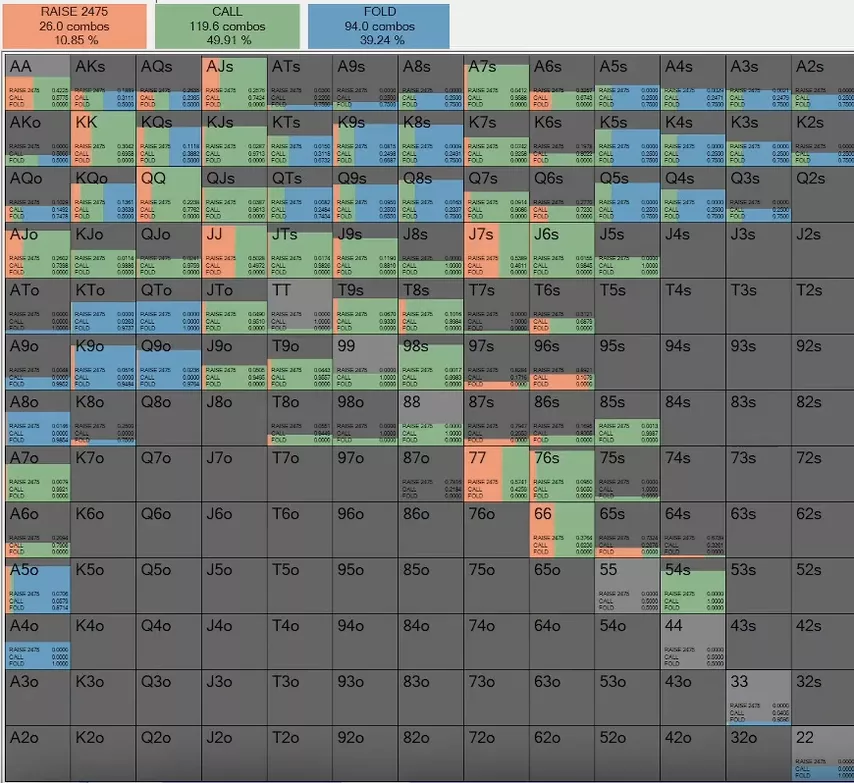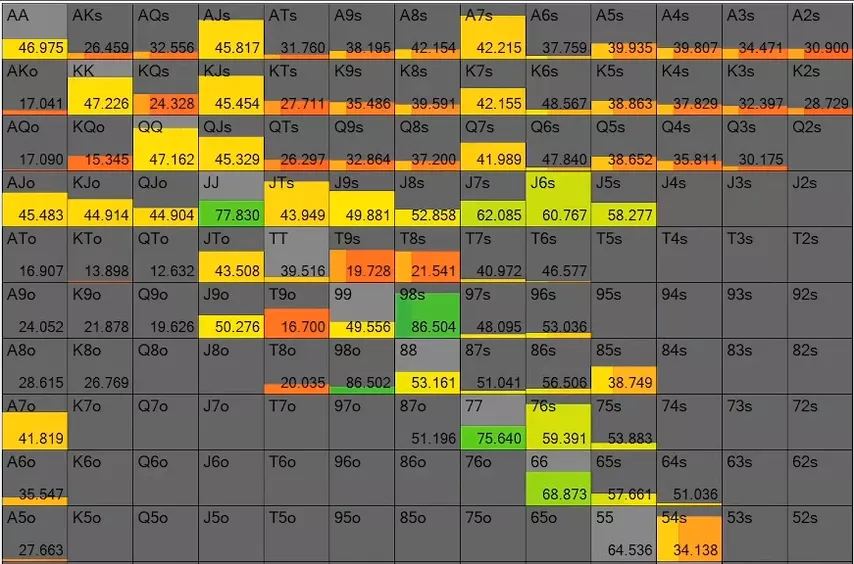Hello everyone, this is Uri from Guerrilla Poker. In this video, we'll break down a hand played by Linus Loeliger and Barak Wisbrod on PokerKing at $100/$200 with a $20,000 buy-in. First, we’ll analyze it on our own, and then connect Piosolver.
So, $100/$200, the effective stack is a little less than 110bb. Linus raises to $500 on the button and Barak defends the big blind.

Barak checks and Linus continuation bets with a large size of $792. In our analysis, we often come across small continuation bets, indicating that the aggressor continues to attack with almost his entire range. Of course, the choice of sizing is influenced by many nuances. Among the reasons why you might prefer an alternative strategy is the presence of a large number of draws. A small continuation bet does not put pressure on the player's multiple draws in the BB and allows him to see the next card cheaply, realizing his equity. A big continuation bet solves this problem.
The sizing chosen by Linus indicates the polarization of his range. You won't see in it , , , , , . All these hands need to be checked, just like , , . In general, it's a polarized range; I hope you are familiar with this term.
And yet, Barak check-raises.

To check-raise a polarized range, you need to make yours even more polarized. It makes no sense to check-raise, say, . I think that against the polarized range such a check-raise shouldn't exist, or, in extreme cases, is very rare. Any two pair or better is, of course, suitable, as are various draws, of which there are a lot on this texture.
Linus calls.

When you see the turn after a check-raise and call, you should immediately ask yourself who this card suits best. (The same approach applies to other cases, of course.) In our case, the turn is, in my opinion, one of the best cards in the deck for Barak Visbrod. became the nuts, we got there with , turned into two pairs with and , have noticeably improved and . In short, a great card for Barak. In general, a check-raiser is more suited to draw-closing cards and small cards, while a caller is more suited to big cards and pairs on board.
Barak barrels, betting $4,026. Almost 80% of the pot; he must play this way with a very large percentage of his range, putting serious pressure on his opponent.
Linus responds by deciding to go all in. Barak calls about $15.5k. Players open cards: top pair with a gutshot against a strong combo draw.

Barak's line is very reasonable. Check-raising with a combo draw is standard. When the hand improves to a pair on the turn, you can sometimes check, but pairing a five, in my opinion, is not very good for this. It can be interpreted simply as additional outs for trips or two pair. Overall a very standard and simple play on Barak's part.
But Linus’s actions, perhaps, could surprise someone. Using this hand to make a big continuation bet on the flop? Well, not always, but with some frequency it is certainly possible. Call a check-raise? Always! But all-in on the turn?!
Let's start with a broad question: should we, in Linus' place, push the turn in principle? And if so, what hands are most appropriate for this?
Obviously, the hands with which Barak barrels this turn have a lot of equity: a combo draw like , , and so on, a ton of outs against top pair, and his value is simply destroyed by J9o. What should Linus's all-in range be? What does its additional part consist of, besides the obvious ? What to bluff with? And which of these categories does J9o fall into?
In my opinion, J9o is more of a bluff than a value, but a bluff that beats the draw and therefore will periodically go all-in from above. That weird GTO bluff where you hit stronger hands but get called by weaker hands. Although Linus would probably prefer to see a fold rather than a call.
Now let's check all of the above in the solver.
On the flop, Barak always starts by checking. I left Linus with only one size, in this case, his strategy looks like this:

The continuation bet is expectedly polarized: Kings and Queens always bet, tens never, nines and eights rarely, and fives never as well. , almost don’t bet it. J9o is a mix with a slight lean towards check.

I guessed wrong about A7o – this hand often goes to continuation bet, but basically, I was not wrong.
The BB solver builds a check-raise like this:

As expected, a polarized check-raise of a polarized continuation bet should not contain many top pairs. Its value part is only sets and two pairs, and bluffs are scattered in the area of cards from eight to four. – 100% check-raise, which, of course, is not at all surprising.
When check-raising, Linus does not fold a single pair and even floats some hands without pairs or draws.

You can see the expectations from different turns in the solver. Indeed, from Barak's point of view, the turn was the best card in the deck, and he should barrel with a large size about 90% of the time. Too much of his range was improved by this five.


Once you understand what is happening a little, the solution immediately becomes very simple.
With hands that Linus wants to continue with, he must choose between all-in and calling – the solver doesn't like a small raise.

Many top pairs start folding, even some should be folded. Stronger hands don't slowplay – except who are too strong and can afford it. J7s, J6s, and 76s immediately go all-in because Barak's range has so much equity that Linus doesn't necessarily need to slowplay.
What to bluff with? There are pushes with overpairs, you can push your own 87s, 86s, 85s – which will be extremely cruel against . And, interestingly, you can bluff with J9o and J9s!

What is the idea behind the all-in? J9o's equity against a large bet on the turn is 50%.

If he faces a raise, Barak will have to fold and – that is, some stronger hands. After his call, J9o's equity will drop to 25%. This is indeed a bluff, but a bluff that does not allow for very much equity to be realized! Barak will fold, for example, , , . Of course, with or folding is not possible.
It turns out that in this hand both players played perfectly on all streets. With amazing accuracy, Linus found a not-so-obvious push combination. Few would push J9o in his place.
Why , but not ? Why not ? How to find such bluffs?
It's not about the specific hand, but the type of hand. We need to understand that the ideal bluff for us would be a hand that beats draws, must call, and has outs against value. meets these conditions.
It makes sense for and . The solver doesn't push with them, but we can always see how big a mistake pushing will be. With we will be one blind short, with – about one and a half. Considering the final pot size is over 200bb, an error of one blind is not that big and is well within the range of errors that we should be willing to accept. I wouldn’t blame anyone for such pushes and I wouldn’t bother myself with the elaborate selection of combinations taking into account the suits.
But Linus did.

The solver pushes a diamond and a heart here – these are the cards Linus had. A perfect and very impressive hand!
From the comments to the video:
-- Linus is damn good. I'm literally shocked by how he finds the right moves.
– He is the Magnus Carlsen of poker!
– If this were a lesser-known player, such accuracy would lead to suspicion...
– I have been following Linus for a long time and do not consider his game suspicious. He just never forgets about his range and looks for the right raises in any situation. That's very rare.








